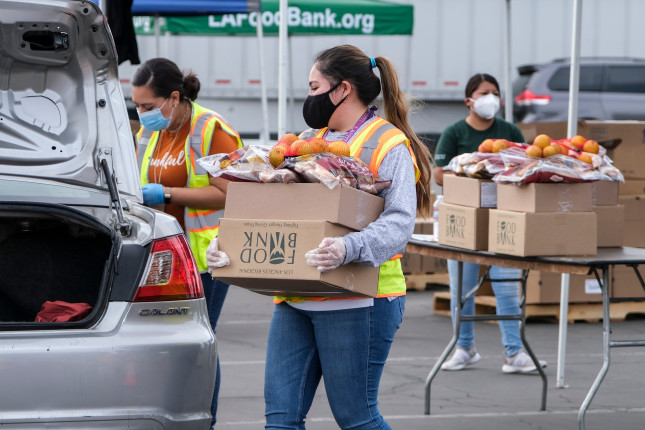-
Who’s responsible for feeding hungry people?
January 5, 2021 By Michelle Jurkovich
Historically, Americans have not been entitled to adequate, nutritious food when they are hungry, at least not at the expense of federal or state governments. Public food assistance programs are and have always been limited and supplemental and not designed to cover all nutritional needs. The effects of limited government engagement with hunger have disproportionately affected women and people of color and resulted in a patchwork system of assistance where charities and privately funded food banks attempt to fill gaps left by the government’s Supplemental Nutrition Assistance Program (SNAP) program.
Hunger in America has received a surge of media attention during the COVID-19 pandemic, but traditionally, Americans have shown a high tolerance for hunger within their borders, at least for select populations of Americans. Before the current pandemic, the USDA estimated a 10.5 percent rate of food insecurity nationally in 2019, but in the case of woman-headed households with children, the rates were a staggering 28.7 percent. Black and Hispanic households had an estimated food insecurity rate of 19.1 percent and 15.6 percent respectively. Very little national attention was paid to these pre-pandemic rates. Few media outlets covered the problem in depth.
These staggering rates of hunger in America were not unique to 2019. The USDA estimates households with children headed by a single woman in the U.S. have endured food insecurity rates of between 28.7 percent and 35.3 percent every year since 2014. Food insecurity rates among Black households has ranged from 19.1 percent to 26.1 percent, and among Hispanic households 15.6 percent to 22.4 percent since 2014. These disparities have only been exacerbated by the COVID-19 pandemic.
Successful anti-hunger advocacy is challenging for many reasons, but one important reason is that consensus on an answer to the question of “who should do what?” to solve the problem has remained evasive. My new book Feeding the Hungry: Advocacy and Blame in the Global Fight Against Hunger (Cornell University Press) examines this challenge among influential international anti-hunger activists, but the lessons learned there are relevant to our conversations here at home as well.
One challenge the hunger issue faces is that while there is a human right to food, which even the U.S. government at times has acknowledged (e.g., in the Universal Declaration of Human Rights (1948) and the Voluntary Guidelines to Support the Progressive Realization of the Right to Adequate Food in the Context of National Food Security (2004), though the U.S. still has not ratified the International Covenant on Economic, Social, and Cultural Rights among other relevant conventions) there remains a striking disconnect between international laws ascribing responsibility to national governments to protect and fulfill the right to food of their citizens and any consensus within a given society that indeed the government is obligated to fulfill this right. We can think of this problem as a difference between laws and norms and it poses serious challenges for successful efforts at reducing hunger at home and abroad.
And yet, in dramatically increasing food insecurity, the coronavirus pandemic may have created an opening in which Americans can reconsider the role of the government in ensuring the right to food to all Americans. It is worth noting the great innovation currently happening in this space, the novelty of which might otherwise be lost with everything else in the news. For example, beginning in March 2020, some states began to implement publicly funded food assistance programming rarely seen in the U.S. In places like New York City, ready-to-eat hot meals are being provided to all who need them (regardless of age, income, or employment status) (recent updates here). In California, novel reimbursement programs were designed to pay restaurants for providing free and reduced cost food to those in need, as well as reforms instituted to allow online purchase through increased P-EBT credits (though the USDA has restricted this online benefit in states like Massachusetts to use at Walmart.com and Amazon.com, raising serious concerns about monopolizing benefits among large corporations).
Perhaps the most visible changes have taken place in modifications to free or reduced cost school lunch programs during the pandemic. Previously, if American children needed a free lunch, they were required to meet specific eligibility requirements and be physically be present at school to receive it. Being a hungry child was not enough to entitle them to the meal—they were required to performed a service in exchange (attending school). In much of America, dinner time, school holidays, weekends, and summer breaks left the same children without a venue for prepared food and existing WIC and SNAP programming did not adequately fill this void. The pandemic has resulted in many school districts making lunches and breakfasts available for pick up without conditions applied, to all children who need them. As we have seen with rising hunger rates, however, this remains an inadequate response, but it does represent a change in conditionalities applied for hungry children to access meals.
The question, for scholars and practitioners alike, is whether these innovations in domestic food assistance will be temporary amendments during the pandemic, or whether they will grow into significant and important long-term changes in how Americans view the obligation of the government to ensure adequate food.
Dr. Michelle Jurkovich is an Assistant Professor of Political Science at the University of Massachusetts Boston and a faculty affiliate at the McCormack Graduate School of Policy and Global Studies. She is the author of Feeding the Hungry: Advocacy and Blame in the Global Fight Against Hunger (Cornell University Press, 2020).
Sources: Brookings Institution, Commonwealth of Massachusetts, Cornell University Press, Food and Agriculture Organization of the United Nations, International Studies Review, New York City Department of Education, Office of the United Nations High Commissioner for Human Rights, Spectrum News NY1, United Nations, United States Department of Agriculture.
Photo Credit: A volunteer loads food into the trunk of a vehicle during a drive-thru food distribution by the Los Angeles Regional Food Bank in Glendora, California, courtesy of Ringo Chiu, Shutterstock.com.
 A Publication of the Stimson Center.
A Publication of the Stimson Center.






